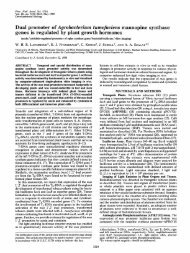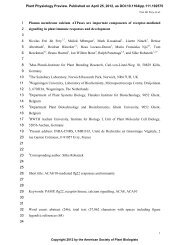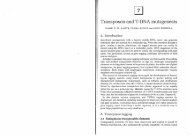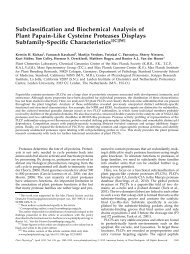A Conserved Domain of the Arabidopsis GNOM ... - The Plant Cell
A Conserved Domain of the Arabidopsis GNOM ... - The Plant Cell
A Conserved Domain of the Arabidopsis GNOM ... - The Plant Cell
You also want an ePaper? Increase the reach of your titles
YUMPU automatically turns print PDFs into web optimized ePapers that Google loves.
350 <strong>The</strong> <strong>Plant</strong> <strong>Cell</strong><br />
Figure 6. Alignment <strong>of</strong> <strong>Arabidopsis</strong> Cyp5 with Related Cyp Sequences.<br />
Alignment <strong>of</strong> seven putative cytosolic eukaryotic Cyp proteins as identified and generated by BLAST P and BEAUTY search with multiple sequence<br />
alignment (Altschul et al., 1997). Dots indicate amino acid identity; dashes represent gaps. <strong>The</strong> Cyp5 sequence contains <strong>the</strong> predicted<br />
N-terminal endoplasmic reticulum (ER) transport signal (Saito et al., 1999) and PPIase consensus (PROSITE, underlined). Peptide antigen for<br />
rabbit immunization and two nonconserved amino acids (asterisks) involved in cyclosporin A binding <strong>of</strong> human CypA are underlined (<strong>The</strong>riault et<br />
al., 1993). An ecotype polymorphism I30V between <strong>the</strong> Landsberg erecta and Columbia sequences is indicated (top line). <strong>The</strong> more divergent <strong>Arabidopsis</strong><br />
ROC4 lacks a seven–amino acid insertion present in <strong>the</strong> o<strong>the</strong>r Cyp proteins.<br />
Cyp5 in <strong>the</strong> cytosol is in agreement with <strong>the</strong> cytoplasmic localization<br />
<strong>of</strong> mouse and rat secretory Cyp, CypB, which has<br />
been attributed to abortion <strong>of</strong> protein translocation after<br />
signal peptide cleavage (Arber et al., 1992; Schumacher et<br />
al., 1994).<br />
<strong>The</strong> mechanism underlying <strong>the</strong> abortion <strong>of</strong> translocation<br />
has been described for <strong>the</strong> hepatitis B virus precore protein<br />
whose translocation is aborted after signal peptide cleavage,<br />
releasing <strong>the</strong> major part <strong>of</strong> <strong>the</strong> mature form into <strong>the</strong> cytosol<br />
(Garcia et al., 1988). Cyp5 may be localized to <strong>the</strong> cytosol in a<br />
similar way. Cyp5 interaction with cytosolic targets is also<br />
suggested by sequence similarity to cytoplasmic Cyp proteins<br />
from o<strong>the</strong>r eukaryotes. Toge<strong>the</strong>r, our data suggest that<br />
<strong>the</strong> cytosol and possibly membrane fractions are cellular<br />
compartments relevant for <strong>the</strong> <strong>GNOM</strong> and Cyp5 interaction.<br />
Saito et al. (1999) proposed that Cyp5 plays a role in<br />
postembryonic development ra<strong>the</strong>r than acting as a stressresponsive<br />
chaperone. Our study shows that Cyp5 protein is<br />
an enzyme with protein folding activities that is also expressed<br />
during embryogenesis, accumulating preferentially<br />
in inner cells at later stages. Early ubiquitous localization <strong>of</strong><br />
Cyp5 coincides with irregular divisions affecting whole<br />
gnom embryos during early stages (Mayer et al., 1993).<br />
Moreover, epidermal cells are less strongly affected in gnom<br />
embryos (Mayer et al., 1993), which is consistent with ceasing<br />
Cyp5 localization in epidermal cells at <strong>the</strong> heart stage.<br />
Thus, expression <strong>of</strong> Cyp5 in cells affected in gnom mutant<br />
embryos is consistent with a presumed interaction <strong>of</strong> <strong>the</strong><br />
<strong>GNOM</strong> and Cyp5 proteins, as suggested by <strong>the</strong>ir specific interactions<br />
in yeast and in vitro.<br />
Proteins involved in signal transduction, such as receptor<br />
kinases, are known to be activated by dimerization (Weiss<br />
and Schlessinger, 1998). By analogy, <strong>GNOM</strong> dimerization<br />
may be required for ARF GEF activity because <strong>GNOM</strong> function<br />
is restored by genetic interaction <strong>of</strong> certain gnom mutant<br />
alleles producing full-length protein that is inactive on<br />
its own (Busch et al., 1996; Steinmann et al., 1999). <strong>The</strong> DCB<br />
domain required for <strong>GNOM</strong> subunit interaction also binds to<br />
Cyp5. So what role might Cyp5 play in <strong>the</strong> presumed regulation<br />
<strong>of</strong> <strong>the</strong> ARF GEF activity <strong>of</strong> <strong>GNOM</strong> <strong>The</strong> Cyp5 protein<br />
displayed PPIase and protein refolding in vitro activities, which<br />
were effectively inhibited by cyclosporin A, thus identifying<br />
Cyp5 as a new potential cyclosporin A target in <strong>Arabidopsis</strong>.<br />
<strong>The</strong>se observations suggest a role for Cyp5-mediated protein<br />
folding in regulating <strong>GNOM</strong> activity, although <strong>the</strong> details<br />
<strong>of</strong> this interaction remain to be determined.<br />
Interactions between cyclophilins and respective dimerizing<br />
or oligomerizing target molecules have been analyzed in<br />
a few cases. A competitive activation mechanism has been<br />
implicated in <strong>the</strong> interaction <strong>of</strong> yeast Hsp90 with <strong>the</strong> cyclophilin-40<br />
homolog Cpr6 (Prodromou et al., 1999). Cpr6 displaces<br />
<strong>the</strong> inhibitory cochaperone STI1 in a competitive<br />
manner, restoring Hsp90 ATPase activity in vitro (Prodromou<br />
et al., 1999). <strong>The</strong> mouse STI1 homolog, Hop, and Cyp40<br />
have been shown to bind to <strong>the</strong> Hsp90 dimerization domain<br />
(Carrello et al., 1999). However, this Cyp40 interaction in-






